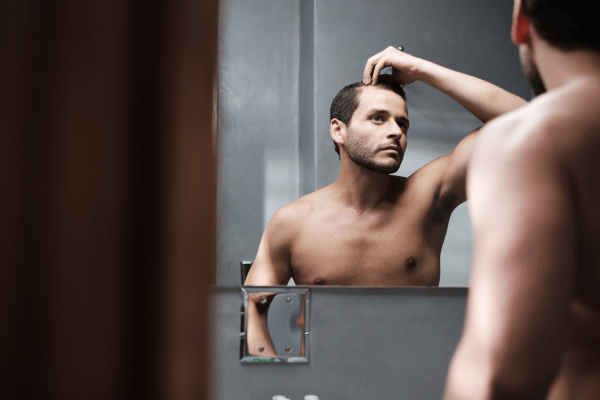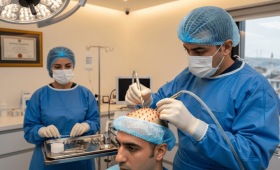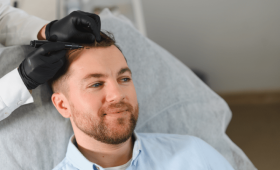When Is The Final Appearance Achieved After Hair Transplantation?
The final and complete appearance achieved after hair transplantation is generally completed between 12 and 18 months after the surgery. This long period is necessary for the transplanted hair follicles to exit the resting phase (telogen), start growing again, transition from thinness to thickness, and fully adapt to the natural hair texture.
Especially for hair in the crown and posterior regions, reaching full density and maturity can take up to 18 months. As Cure Holiday, we guide you step-by-step to patiently manage this long process and provide detailed updates on the expected progress each month, thus helping you keep your expectations realistic throughout the journey.
How Many Months Does It Take For Hair To Start Growing Visible From The Start Of The Surgery?
Hair typically starts to become visibly noticeable, emerging from the scalp, around the 3rd month following the surgery. Shock hair loss occurs in the first month, and the scalp is in a resting phase during the second month.
Starting from the third month, the roots transition from the telogen phase to the anagen (growth) phase, pushing the hair shafts to the surface. These first emerging hairs might be initially thin and weak (like vellus hair), but they thicken and strengthen over time. This early growth period is a morale-boosting milestone for patients, and Cure Holiday may recommend supplementary treatments following this period.
When Does Shock Hair Loss Begin And How Long Does It Last?
Shock hair loss begins between the 2nd and 4th weeks after hair transplantation and typically lasts for 1 to 2 months. During this process, the hair shafts in the transplanted area rapidly fall out; this is an expected and healthy process showing that the roots are adapting to their new location, and it does not mean the roots have died. Once shock hair loss is complete, the roots begin to produce new and permanent hair shafts. This period can be psychologically challenging, but Cure Holiday supports you in managing this temporary phase and encouraging patience during the waiting period.
When Do The Redness And Scabbing Seen On The Scalp In The First Three Months Disappear?
Scabbing (clotted blood and tissue fluid) on the scalp generally sheds completely with the 10-day special washing procedure after the surgery, and this stage is a critical threshold indicating the safety of the grafts. The redness that appears after the scabs shed is caused by increased blood circulation and the healing process. Redness gradually fades and disappears within 2 weeks to 2 months, depending on the skin type and healing rate. Avoiding sun exposure during this period is vitally important to prevent the redness from becoming permanent (hyperpigmentation).
What Percentage Of Newly Transplanted Hairs Have Grown By The Sixth Month?
Generally, approximately 50 to 60 percent of the transplanted hair follicles become visibly noticeable by the 6th month after the surgery. This six-month milestone is when the hair starts growing and the patient begins to see a significant difference in density for the first time. The hair may still be relatively thin, not having reached full maturity at this stage, but it clearly demonstrates the change in the transplanted area. At Cure Holiday, we recommend comparing photos taken during this month with your pre-surgery status to boost your motivation.
When Does The Final Shape And Naturalness Of The Hairline Settle?
The final shape and naturalness of the hairline, along with the thickening of the other hairs, generally settle completely between 9 and 12 months. After the initial transplantation along the line, the hair may look stiff and artificial in the first few months; however, the angle, direction, and softness of the hair shafts improve over time. The maturation of the single grafts used in the very front row ensures a soft transition, making the line look completely natural. Cure Holiday surgeons work with millimetric precision to design the most natural-looking frontal hairline.
How Long Does It Take For The Donor Area To Fully Heal And The Scars To Disappear?
The healing of the redness and scabbing on the surface of the donor area (nape) usually takes 2 to 4 weeks. However, it can take 6 to 12 months for the micro-scars resulting from FUE or DHI techniques to completely fade and for the hair in the area to return to its previous state, covering the gaps. The complete healing of the donor area and ensuring no visible scarring is achieved by using this area at an appropriate density. Avoiding massage and harsh brushing in the donor area during this period is important.
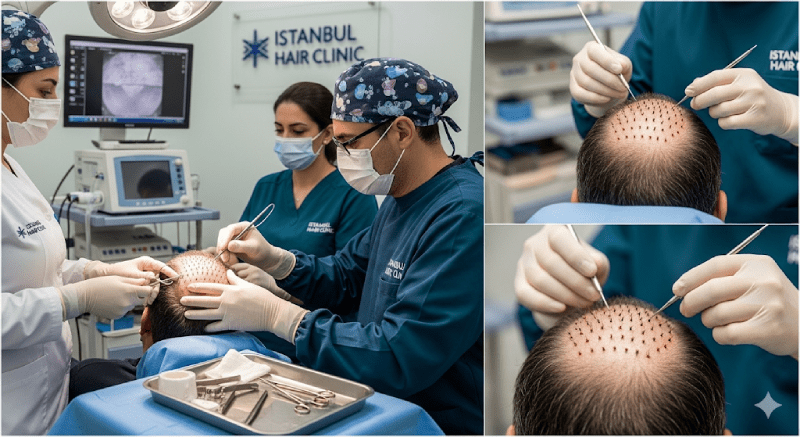
When Does The Thickening And Maturation Of The Newly Transplanted Hairs Begin?
The thickening and maturation of the newly transplanted hairs usually begin from the 6th month onwards. The hairs that grow between the 3rd and 6th months are fine (vellus) in structure, but by the 6th month, the hair roots receive full blood flow and start producing stronger, thicker (terminal) hair shafts. This thickening process continues intensively until the 12th month, noticeably increasing the fullness in the transplanted area. Supportive treatments like PRP may be recommended to accelerate this period.
When Does The Sensation Of Numbness And Tingling After Hair Transplant Disappear?
The temporary feeling of numbness or tingling experienced in both the transplanted and donor areas after hair transplantation is normal and can last from a few weeks to 6 months. This condition is caused by the temporary effect on the nerve endings during graft harvesting and placement. Sensation gradually returns over time. Permanent numbness is rare. At Cure Holiday, patients are informed that this is a normal part of the healing process, not a complication, and vitamins supporting nerve recovery may be recommended.
What Does One Hundred Percent Success Mean In Hair Transplant And When Is It Confirmed?
One hundred percent success in hair transplantation means that the vast majority of the transplanted grafts (90%+) survive, a natural hairline is achieved, and the patient’s aesthetic expectations are met. Confirmation of this success rate is possible with the final evaluation performed after the 12th month, when the hair has reached full maturity. Success is measured not only by the number of hairs that grow but also by the hair’s direction, angle, and naturalness. Cure Holiday works with specialists aiming for the highest survival and satisfaction rates.
Do PRP Or Mesotherapy Treatments Affect Hair Growth Speed?
Yes, supportive treatments like PRP (Platelet-Rich Plasma) or mesotherapy can positively affect the speed and quality of hair growth after transplantation. These treatments provide hair follicles directly with growth factors, vitamins, and minerals, encouraging the roots to transition faster from the telogen phase to the anagen (growth) phase. These supplements, administered early, can help the hair grow faster and thicker after shock hair loss.
What Is The Minimum Time That Should Be Waited To Dye Hair After Hair Transplant?
A minimum of 4 to 6 months must be waited to dye hair after hair transplantation to allow the scalp to fully heal and prevent chemical damage to the transplanted roots. The scalp is still sensitive during this period, and chemical ingredients can harm newly secured grafts. Even after the 6th month, the use of ammonia-free and organic-based dyes is recommended. Avoiding contact of chemicals with the scalp is critical for maintaining the success of the transplantation.
How Do Hair Transplant Results Change From The First Month Onwards?
Hair transplant results from the first month generally show a noticeable regression period. The scabs shed in the first week, but shock hair loss begins from the first month onwards, and the majority of the transplanted hairs fall out. Although the scalp looks clean during this period, the appearance may be sparser than before the transplantation. Patients must maintain high morale, as this is proof that the roots are working beneath the surface and preparing for the new growth phase.
When Should A Second Transplant Be Decided Or How Long Should One Wait Before A Second Session?
Before deciding on a second transplant (revision or density increase), it is mandatory to complete the full 12 months required for the final result of the first transplant. Since the hair does not reach full maturity before the 12th month, making an early decision can lead to faulty planning. At the 12th month, the density in the transplanted area and the condition of the existing hair are evaluated. If the desired result has not been achieved and the donor area is sufficient, Cure Holiday will assist you in planning a suitable second session.
When Can Sports And Heavy Exercise Be Resumed After Hair Transplant?
It is recommended to wait at least 4 to 6 weeks before resuming sports and heavy exercises (weightlifting, running, swimming) after a hair transplant. Strenuous activity is strictly forbidden for the first 10 days. Light-paced walking can be started after 2-3 weeks. Heavy exercises can increase blood pressure in the scalp, potentially harming the transplanted area, or raise the risk of infection through sweating. A full return should be made gradually after the 6th week, with your surgeon’s approval.
What Is The Maximum Duration Of Swelling (Oedema) After Surgery?
Swelling (oedema) that occurs after hair transplantation usually reaches its peak between the 3rd and 5th day after the surgery and then rapidly begins to subside. Oedema becomes prominent usually around the forehead and eyes. This period can be shortened by keeping the head elevated, applying ice for the first 48 hours, and regularly using the anti-oedema medications provided by the surgeon. Swelling generally disappears completely within 7 to 10 days and greatly affects the return to social life.
Between Which Months Does The Transition Of Hair Shafts From Thinness To Thickness Occur?
The transition of hair shafts from thinness to thickness (vellus to terminal hair) usually occurs rapidly between the 6th and 12th months. The hair that grows between the 3rd and 6th months is fine (vellus) structured, but from the 6th month onwards, the hair roots receive full blood flow and start producing stronger, thicker (terminal) hair shafts. This thickening process continues intensively until the 12th month, visibly increasing the density in the transplanted area. Using balanced nutrition and recommended vitamin supplements to support this process directly affects the quality of the final result.
What Is The Structure Of The Newly Grown Hairs When They First Emerge After Surgery?
The new hairs that first emerge after surgery generally have a thin, curly, irregular, and weak structure. This is normal because the roots are trying to adapt to their new channels and have not yet reached their full strength. These hairs will mature and thicken over time, adapting to the texture and colour of your existing natural hair. It is important for patients to be patient with this initial “baby hair” appearance and maintain high morale.
Why Is 18 Months Important For Confirming The Success Of Hair Transplant?
Waiting 18 months for the confirmation of hair transplant success is necessary, especially because blood supply is slower in challenging areas like the crown and vertex. The hair growth cycle is a long process, and some roots mature later than others. This 18-month period is the guarantee period during which all transplanted grafts reach maximum thickness, density, and natural compatibility. As Cure Holiday, we finalize your result with final checks performed no later than the 18th month.
How Long Does The Headache Or Sensitivity That Occurs After Surgery Last?
The headache or scalp sensitivity that occurs after surgery usually begins when the local anaesthesia wears off and is most intense within the first 24-48 hours. This pain can be easily managed with prescribed painkillers. The sensation of sensitivity can last for a few weeks. If the pain becomes severe and uncontrollable, you should immediately inform your doctor. This condition is temporary and is a normal part of the healing process.
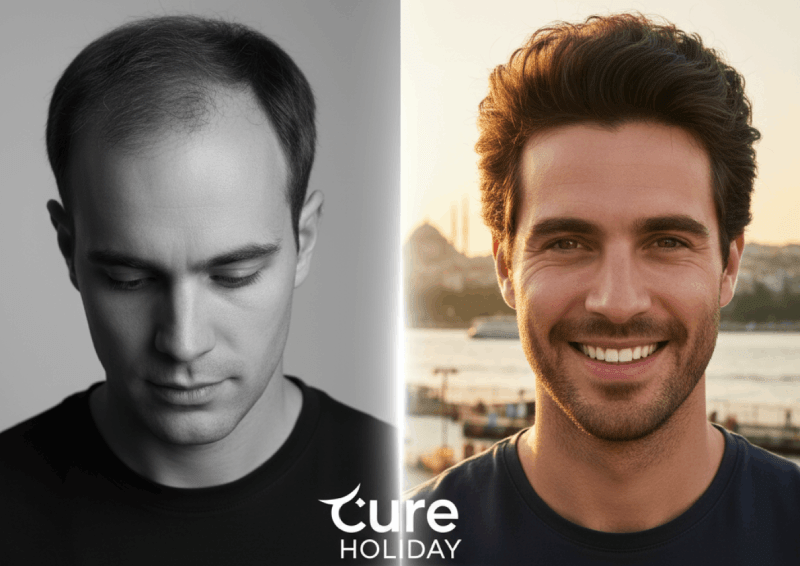
Is The Length Gain Achieved After Hair Transplant Permanent?
Hair transplantation is a procedure aimed at producing hair shafts, not lengthening the body. The achieved results (new hair shafts) are permanent, because the roots taken from the donor area are genetically resistant to hair loss. These resistant roots continue not to shed in their new transplanted area. However, since genetic hair loss may continue in the existing hair that was not transplanted, it is important to continue supportive treatments to preserve this hair.
Is There A Difference In The Result Time Between DHI Technique And FUE Technique?
There is no major difference in the final result time between the DHI (Direct Hair Implantation) technique and the FUE technique (both 12-18 months). However, since the DHI technique allows for more delicate transplantation and densification among existing hairs, it can help the patient go through the shock hair loss period more lightly and shorten the return time to social life. These minor differences provide significant advantages, especially for women and patients who prefer unshaven transplantation.
How Does Smoking Or Alcohol Consumption Affect Hair Growth Time?
Smoking and alcohol consumption are the biggest enemies that negatively affect the hair growth time and quality after hair transplantation. Nicotine restricts blood flow in the capillaries, preventing the nourishment of the transplanted grafts. This situation can lead to the hair growing later, remaining thinner, and reducing the survival rate. Therefore, completely abstaining from these habits for at least 4-6 weeks before and after the surgery directly determines the speed and success of the result.
When Do The Newly Transplanted Hairs Fully Match The Existing Hairs?
When the thickening and maturation processes are complete, the newly transplanted hairs usually fully match the existing hairs around the 12th month. Compatibility occurs in terms of colour, texture, thickness, and most importantly, the angle of direction. The surgeon’s careful work in transplanting at the correct angle and direction is the foundation of this compatibility. The moment you can comfortably comb, style your hair, and it does not look noticeably different in various conditions is when full compatibility is achieved.
When Are The Acne And Oiliness That Occur After Hair Transplant Brought Under Control?
It is normal to experience acne (folliculitis) and oiliness in the transplanted area after hair transplantation; this is caused by the new hair shafts trying to penetrate the skin surface. This condition usually intensifies between the 2nd and 4th months. It is controlled with correct washing techniques, special lotions provided, and in some cases, antibiotic creams. Generally, acne decreases after the 5th month, and the healing process accelerates.
Does Shock Hair Loss Necessarily Occur In Every Patient?
Shock hair loss is observed in the vast majority (around 90%) of patients who undergo hair transplantation, so it is considered an almost inevitable process. However, the severity and duration of the shedding can vary from person to person. In very rare cases, shock hair loss may not occur or may be very mild. This is dependent on the patient’s skin type, genetics, and the technique of graft harvesting and placement. Not experiencing shock hair loss can also be a sign of good graft survival, not failure.
What Is The Minimum Time That Should Be Waited For A Haircut After Hair Transplant?
It is generally considered safe to wait 1 month before having a haircut with scissors after hair transplantation. However, it is recommended to wait at least 3 to 6 months before using electric clippers or a razor blade on the transplanted area, to ensure the roots are fully secured. Hair in the donor area can usually be trimmed after 2-3 weeks. In the first months, pressure on the transplanted area should be absolutely avoided when cutting hair.
What Is The Most Critical Point To Be Aware Of In The First Week Of The Surgery?
The most critical point to be aware of in the first week of the surgery is to prevent the dislodgement (trauma) of the transplanted grafts. This means avoiding pillow contact with the transplanted area during sleep, avoiding impact, abstaining from alcohol/smoking, and especially avoiding contact with water for the first three days. Cure Holiday provides you with a special neck pillow and detailed protection instructions to use during the first week. The first 10 days are vital for the survival of the result.
Is It Normal For New Hairs To Be Irregular Or Curly?
Yes, it is normal for the first emerging hair shafts after hair transplantation to be irregular, curly, or have a different texture. This is due to the graft experiencing trauma and the follicle temporarily changing shape as it grows out of the new channel. The hair returns to its old natural texture and straightness as it grows and matures (usually within 6-12 months). This temporary change does not mean there is a permanent problem, and your Cure Holiday doctor will reassure you about this.
How Is The Thickness Achieved After Hair Transplant Measured And Evaluated?
The thickness achieved after hair transplantation is usually measured by density (number of hair shafts/grafts per cm²) and hair shaft diameter. Density is generally determined by the pre-transplantation planning. Hair shaft thickness is evaluated by comparing it visually or with special microscopic devices. The final thickness evaluation is performed after the 12th month, when the hair has reached full maturity. This evaluation is the most objective data showing the patient’s satisfaction and surgical success.
When Does Scalp Itching Start After Surgery And How Does It Go Away?
Scalp itching after surgery is a sign of the healing process and nerve regeneration and usually starts from the 2nd or 3rd week onwards. Itching can be irritating during this period when scabs are shedding and healing accelerates. Special lotions, moisturisers, and cold spray recommended by your surgeon can be used to relieve the itching. Scratching must be absolutely avoided, as this can harm the secured grafts.
What Is The Earliest Month A Second Hair Transplant Can Be Performed?
A second hair transplant (second session) can be performed at the earliest 12 months after the first transplant, for the donor and recipient areas to fully heal and for the final result of the first transplant to be visible. For rare and minor corrections, 6 months may be waited, but the general rule is 1 year. This waiting period is critically important for preserving the health of the donor area and achieving high success from the second transplant. Cure Holiday specialists meticulously adhere to this period in planning the second session.
What Is The Duration Of Sun Protection After Hair Transplant?
The duration of sun protection after hair transplantation is at least 1 to 3 months. The newly transplanted roots and healing skin are very sensitive to ultraviolet rays, and exposure to direct sunlight can cause permanent discolouration (hyperpigmentation) or damage to the roots in the transplanted area. Wearing a loose and breathable hat recommended by your doctor when going outside is mandatory for the first month.
What Is The Importance Of The Shampoo Or Lotion Used After Hair Transplant?
The special shampoo and lotions used after hair transplantation are of vital importance during the first 10 days of the washing process. Lotions soften the scabs and facilitate their shedding, while special shampoos gently cleanse the transplanted area and minimize the risk of infection. Chemicals in regular shampoos can damage sensitive roots during this period. Cure Holiday will provide you with all the necessary care products to use during this critical period.
What Are The Biggest Factors That Adversely Affect The Success Of The Surgery?
The biggest factors that adversely affect the success of the surgery are smoking, the surgeon’s inexperience and incorrect technique selection, trauma to the grafts (impact/friction) after the surgery, infection, and the presence of the patient’s chronic diseases (such as uncontrolled diabetes). Minimizing these risks directly increases the quality of the final result. By choosing Cure Holiday, you minimize the risks associated with inexperienced surgeons and non-modern techniques.
Is It Normal For New Hairs To Start Shedding And When Does It Occur?
It is not normal for new hairs to start shedding again, as the transplanted roots are resistant to hair loss. If a significant proportion of the hair that has grown out after transplantation starts shedding, this may indicate an underlying problem such as malnutrition, a hormonal issue, or an incorrect transplantation technique (not taking roots from the healthy donor area). In this case, Cure Holiday specialists should be consulted immediately, and the situation should be analysed.
Is The Hair Transplant Results Timeline Different For Women Than For Men?
The hair transplant results timeline for women is fundamentally not different from men (the same 12-18 month waiting period). However, since unshaven transplantation is frequently performed on women, the existing long hair can better camouflage the newly grown hair after shock hair loss, which makes the aesthetic struggle of the patient easier. Since the effect of hormonal fluctuations on hair loss is greater in women, supportive treatment (PRP) after transplantation plays a more critical role.
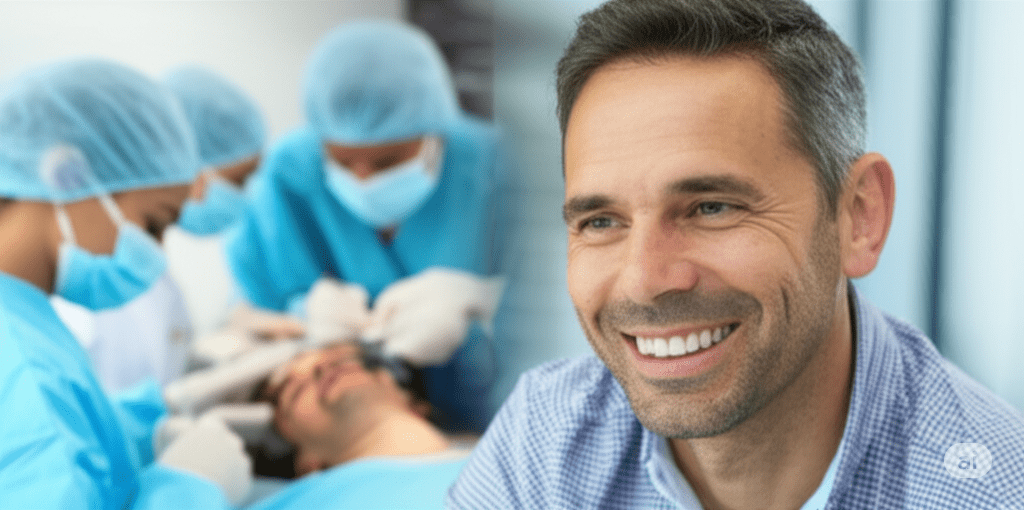
Will The Hair Shafts Turn Grey Or Change Colour After Hair Transplant?
A temporary lightening or greying of the new hair’s colour can rarely be observed due to stress and trauma after the surgery. However, this condition is generally temporary. The natural colour of the hair shafts returns as the hair roots fully mature and begin to produce melanin pigment again. Permanent colour change is usually related to genetics or the aging process and is not caused by the transplantation procedure.
How Does Keeping The Head Elevated After Surgery Affect The Healing Time of Swelling?
Keeping the head elevated (in a sleeping position) after surgery significantly accelerates the healing time of swelling. Keeping the head above the level of the heart prevents excess fluid and oedema from descending to the face and eye area due to gravity. Adhering to this rule for the first 3-5 days is vital for keeping swelling and, consequently, the feeling of pain to a minimum. Cure Holiday provides patients with specially designed neck pillows.
When Do Medications And Vitamins Start To Accelerate Hair Growth?
The medications (e.g., Minoxidil) and vitamin supplements recommended by your doctor usually start to accelerate hair growth between 3 and 6 months. These products increase blood flow in the channels containing hair roots and provide nutrients to the roots. Regular and long-term use is mandatory for their effects to be seen. These supportive treatments make a significant difference, especially in the thickening and densification process of the hair after the 6th month.
When Do The Small Red Dots (Punctures) That Occur After Surgery Disappear?
The small red dots (Punctures) that form in the transplanted area after the surgery and shed along with the scabs are the marks of the micro-channels where the grafts were placed. These red marks appear after the scabs shed (10th day) and generally disappear completely within 2 weeks to 2 months, depending on the skin type. These marks are part of the healing process and do not leave permanent scars.
When Can Hair Be Combed And Styled After Hair Transplant?
Combing must be strictly avoided for the first 10 days after hair transplantation. When the scabs shed after the 10th day, gentle combing can be started with soft and wide-toothed combs. Waiting 2 to 3 months is required for fully styling the hair, blow-drying, or using styling products, for the grafts to be fully strengthened and secured. Excessive force applied before this period can harm the roots.
How Does Infection During The Healing Process Delay The Result?
The occurrence of an infection during the healing process is the most critical complication that significantly delays the surgical result and hair growth, or can even lead to the loss of transplanted grafts. Infection prevents the grafts from securing. Even if the infection is controlled with antibiotic treatment, it can take months for the transplanted area to recover and the hair to start growing. Therefore, strict adherence to hygiene rules is vital for the result not to be delayed.
What Is The Most Critical Period For Hair To Reach Sufficient Density After Surgery?
The most critical period for hair to reach sufficient density is the maturation and thickening phase between the 6th and 12th months. While the first 6 months only show the growth of hair, this critical period ensures that the fine hair shafts that have grown thicken and gain volume, making the transplanted area fuller. Regular doctor check-ups, proper nutrition, and avoiding stress during this period help maximize density.
When Can Hair Extension Start With New Hairs After Surgery?
After hair transplantation, there is technically no waiting period to start the process of growing hair long (leaving a long hairstyle). However, waiting generally 10 to 18 months is required for the transplanted hair to reach the same length as the existing hair and create an aesthetically pleasing appearance. The hair grows noticeably after the 6th month, but styling it long provides the best result after it has reached its full thickness.
How Does The Pre-Operative Evaluation Affect The Speed Of The Result?
A detailed and accurate pre-operative evaluation indirectly affects the speed of the result. Determining the correct number of grafts, accurately analysing the donor area quality, and identifying the patient’s cause of hair loss allow the surgeon to choose the most suitable technique (DHI, FUE). Correct planning aims to achieve maximum success in a single session by preventing unnecessary revisions and delays. Cure Holiday bases its pre-assessment on this meticulousness.
From Which Month Onwards Does It Become Unnoticeable That I Had A Hair Transplant?
It generally starts to become unnoticeable to others that you had a hair transplant between the 3rd and 6th months. After the shock shedding process ends (2nd month) and new hair starts growing from the 3rd month onwards, the transplanted area becomes camouflaged, especially as the length and density of the hair increase at the 6th month. This period can be even shorter for female patients who use long hair or for unshaven transplantation.
When Does The Colour Of The Scalp Completely Return To Normal After Hair Transplant?
The colour of the scalp returns completely to normal within 2 weeks to 2 months after the redness has completely faded. This period can extend up to 3 months for patients with very fair and sensitive skin. Avoiding direct sunlight and harsh chemicals during this process helps the skin colour recover quickly and healthily. Permanent discolouration (hyperpigmentation) can occur if sun protection is not taken seriously.
What Is The Minimum Period For Psychological Satisfaction To Be Seen After Surgery?
The minimum period for psychological satisfaction to be seen after surgery is generally around the 6th month. This is when half of the hair has grown out, and the aesthetic change is now visibly noticeable. The patient’s self-confidence significantly increases during this period. Full psychological satisfaction and complete adaptation to the new image occur at the 12th month, when the final result is achieved. Cure Holiday offers psychological support suggestions to maintain patients’ motivation during this process.
How Is Hair Growth Speed Affected By Genetic Factors?
Hair growth speed and thickness are greatly affected by genetic factors. In some individuals, the hair growth cycle may be inherently faster, and results may reach full density even by the 10th month. However, if you have genetics that cause slow growth, it may be necessary to wait up to 18 months to see the final result. Your surgeon will provide you with a personalized estimated timeline by evaluating your genetic background.
What Should I Do To Take The First Step And Learn About The Detailed Process For The Surgery?
To get detailed information about the hair transplant process and take the first step, you should contact Cure Holiday. Our experienced coordinators will perform a pre-assessment of your current hair loss status (with photos and reports, if available). This allows our expert surgeons to provide you with information about the most suitable transplantation technique, estimated graft count, waiting time, and a personalized results timeline. Cure Holiday is ready to safely manage the planning of your entire treatment journey.
